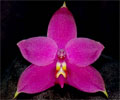|
|
|
|
|
| |
Flasks of
Phalaenopsis violacea 'Amazon' × sib 'Best' |
|
| |
|
|
| |
| Number: |
TN6415 |
| Name: |
Phalaenopsis violacea 'Amazon' × sib 'Best'
|
| Type: |
sib (What's that?) |
|
Seed Donor: |
Rachael L. Tate-Adams
|
|
Click to Enlarge

Pod Parent Flower |
Click to Enlarge

Pollen Parent Flower |
|
|
|
| |
Culture Notes from Donor: Pod parent plant: Phalaenopsis violacea is a warm-growing phalaenopsis species with fragrant magenta flowers. Mine generally grow in a temperature range of 60°F through 90°F (I-W).
Comments: This cross, 'Amazon' x 'Best' is a sib-cross of 'Royalty' x 'Ken's Blue', hoping to further isolate the coerulea gene and produce some coerulea progeny with rich, saturated color.
Pod parent plant: Phal. violacea 'Amazon' is from the cross of 'Royalty' x 'Ken's Blue', so it carries the coerulea gene. It is the largest and most vigorous plant I have of that grex, as well as having great color saturation. The name 'Amazon' doesn't refer to origin, but to its size and growth rate in comparison to its sibs. This is a trait that I hope it passed on to its progeny. Medium-sized plant.
For additional origin/habitat information supplied courtesy of
Charles and Margaret Baker, see further below, near the bottom of this page.
|
Temperatures we attempt to use in the lab & greenhouse:
| For Species: |
|
Spring, Summer, Autumn: days average 89°F, nights 73°F; best fit is Warm 90-70°F
(Source:
Baker's Web OSC) |
| For Species: |
|
Winter: days average 84°F, nights 74°F; best fit is Warm 90-70°F
(Source:
Baker's Web OSC) |
| For Genus: |
|
Spring, Summer, Autumn, Winter: days average 87°F, nights 64°F; best fit is Warm-Intermediate 87-64°F
(
) |
|
About the name...
| Etymology of |
Phalaenopsis |
|
From Greek, "phalaina" moth; "-opsis" appearance.
(Source:
Pridgeon 1992) |
| Etymology of |
violacea |
|
From Latin "violaceus" purple.
(Source:
Mayr & Schmucker 1998) |
| Pronunciation of |
Phalaenopsis |
|
fail-eh-NOP-sis
(Source:
Pridgeon 1992) |
| Pronunciation of |
Phalaenopsis |
|
fal-eye-NOP-sis
(Source:
Hawkes 1978) |
| Pronunciation of |
violacea |
|
vy-oh-LAH-see-ah
(Source:
Hawkes 1978) |
|
If you would like to direct someone to this web page, please copy and paste this URL into your email:
http://troymeyers.com/d?016415
| Flask Information |
| Availability: |
We have sold all of the flasks for this item. |
| You should: |
Consider getting individual plants or compots instead of a flask.
You can place a "Notify Flask Recipients" Request, and either we or a flask recipient may contact you when plants are available.
You may also place a "Notify Retries" Request, and if an identical pollination (the same parents) is done again, we'll let you know.
You may reserve a flask, but it's very unlikely you'll get one ...this could only happen if we found a flask that we didn't know we had. |
| Yield Estimate: |
136 plants (based on flask surveys done 08/06/2009 through 01/10/2012)
|
| Plantlet Sizes: |
From many flasks 8 - 80 mm plants (based on flask surveys done 11/09/2009 through 03/28/2012)
From one most recently surveyed flask 20 - 55 mm (03/28/2012)
|
|
You might also want to:
|
View the seed assay for this item.
View items of the same species.
View items of the same genus.
|
| Ordering Information |
| You are not currently logged in. |
|
You must be a registered user and be logged in to reserve a flask or place a notification request. Please log in:
|
|
|
|
|
|
| |
The origin/habitat information below is supplied courtesy of Charles and Margaret Baker
The following information is based on the name of the plant provided by the donor, and assumes that the name is correct. If the plant has been misidentified, then the following information may not be correct.
This text is copyrighted by the Bakers and may not be reproduced without permission.
ORIGIN/HABITAT: Borneo, Sumatra, and Malaya. It usually grows on shady
trees near lowland rivers, sometimes with P. sumatrana.
More about this information and the Bakers...
|
|
|
| |
|
|
|